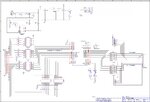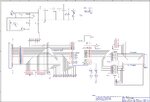Ranbeer Singh
Full Member level 5

- Joined
- Jul 30, 2015
- Messages
- 259
- Helped
- 22
- Reputation
- 44
- Reaction score
- 22
- Trophy points
- 1,298
- Location
- Faridabad India
- Activity points
- 3,266
Hello friends,
I have solved many of my critical problems with help of yours and i am so obliged for your helps.
At this time my concerned was for designing a bus door's controller PCB with electromagnetic compatibility (EMC). Honestly i don’t have a good knowledge of EMC designing for PCB.
Controller circuit is given in attachment, i am using through-hole components & there is no analogical circuit inside. I read in a book that we would be most carefully design with through-hole components. I know... respect to switching output signals, basically, only worry about signals that make an edge transition at a rate greater than 50 kHz. If a pin changes its state at a rate of less than once per 100 instructions, this is acceptable because the contribution from switching is negligible. If the pin toggles, and toggles back on the next instruction, and remains static for 100 instructions, it, too, is acceptable because it contains the same amount of energy.
My all inputs & outputs will not work on high frequencies. It will work less then 1Hz but may be
there will be other types disturbances like EMF, ESD, EOS & etc.
Someone said me that EMC testing procedure is very costly. So i am afraid and not able to pay off it's cost 2-3 times.
Please help.
I have solved many of my critical problems with help of yours and i am so obliged for your helps.
At this time my concerned was for designing a bus door's controller PCB with electromagnetic compatibility (EMC). Honestly i don’t have a good knowledge of EMC designing for PCB.
Controller circuit is given in attachment, i am using through-hole components & there is no analogical circuit inside. I read in a book that we would be most carefully design with through-hole components. I know... respect to switching output signals, basically, only worry about signals that make an edge transition at a rate greater than 50 kHz. If a pin changes its state at a rate of less than once per 100 instructions, this is acceptable because the contribution from switching is negligible. If the pin toggles, and toggles back on the next instruction, and remains static for 100 instructions, it, too, is acceptable because it contains the same amount of energy.
My all inputs & outputs will not work on high frequencies. It will work less then 1Hz but may be
there will be other types disturbances like EMF, ESD, EOS & etc.
Someone said me that EMC testing procedure is very costly. So i am afraid and not able to pay off it's cost 2-3 times.
Please help.






